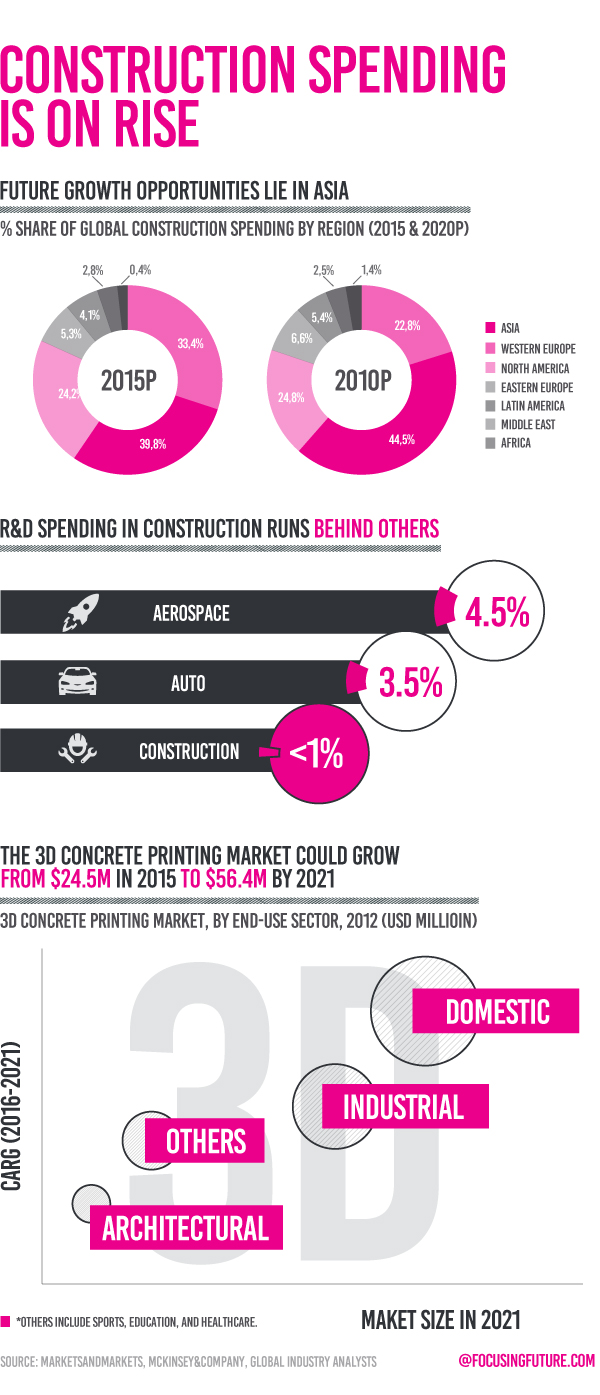![]() 6 minute read
6 minute read
As urbanization grows, it becomes necessary to invest in concepts that improve the efficiency of the production processes and increase awareness of environmental problems. 3D printing and robots are the evolving trends that cater to the needs of rapid population growth. For example, Finland prints walls of fully functioning houses while Japan introduces self-driven bulldozers, but Dubai is already one-step ahead and aims literally even higher.
The problem in facts
Today, the urban population is increasing rapidly with 1.5% rate. Researchers often call it “the largest wave of urban growth” since most of the people either live in cities already or move there. In 2014, 54% of the world population lived in metropole areas, and this growth is expected to upsurge by 1.63% in 2020-2025. This progression leads to higher urbanization rates and changes in spatial designs and landscapes and requires creating more and more spacious buildings. Fast urbanization causes issues with infrastructure and, as a consequence, with water supplies, sanitation, pollution, destruction of national habitats and resources, and extinction of rare wildlife species. Solely, the construction industry is responsible for 4% of total air emissions, and constantly growing demands in it lead to more and more emission of harmful substances and particulate matter in the environment.
Eco-friendly building materials attempt to resolve the problem with space and deal with environmental issues simultaneously. Concrete is slowly losing its dominating positions while being replaced by grasscrete, rammed earth, bamboo, and different recycled materials. Grasscrete is the leading alternative, and it implies using open patterns that allow growing plants and trees on rooftops. This innovation not only enhances the spatial design and urban landscape but also resolves problems related to contamination, as some trees are able to absorb and detain air pollutants. Grass Concrete Limited already promotes, actively uses this concept, and makes “green” roads and parking lots.
The era of robots
has come
Disregarding its drawbacks, construction industry and its development can still be viewed as a solution to deforestation and rapidly growing urbanization problems. Clearly, it can optimize city spaces and take advantage of sustainable and eco-friendly spatial designs to stop the tropospheric ozone pollution and rapidly occurring climate change. Unfortunately, construction segment itself faces problems of underdevelopment. Ineffective time-management and insufficient allocation of resources lead to prolonged deadlines, gigantic budget variances, and high volumes of waste. Yet, this problem can be solved with higher investment in R[&]D, as, now, construction industry devotes less than 1% in adopting new technologies into its essential processes. So, should we still be using traditional methods or give robotics a chance to change the world?

Many manufacturing plants use advanced innovations such as 3D printing, and, basically, robotics and different smart technologies are simply invading the world by making living more ergonomic and convenient. 3D printing, especially, becomes a new trend that can change the whole principle of assembly line introduced long time ago by Henry Ford. This technique enables a creation of three-dimensional imprints and objects by simply using layering and concepts of digital programming. Forbes views this trend as rapidly emerging one, as the value of 3D printing industry is expected to hit a mark of $21 billion in 2022 already. These numbers are just forecasts, but it is clear that this industry has the bright future. Hence, taking advantage of simplicity and efficiency of 3D printing can help the construction industry optimize its waste management and regain its value in terms of R[&]D. It will re-conceptualize the whole idea of architecture, give it an exceptional boost, and move it one step closer to the futuristic future colourfully portrayed in science fiction.
Other then being a pure dream and solution to the construction industry, the companies already try to make “printed” houses a reality. FIMATEC is just one bright example of start-ups that attempt to make 3D printers a significant part of the construction industry. In 2015, Arto Koivuharju founded a company in Finland that was meant to create modular homes with the help of robotics solely. In his speech, Arto highlights that his industrial computerized masterpiece can resolve current dilemmas of the construction industry: it reduces production costs by 10-20% and speeds the whole process by 80%. Now, it is possible to see that creating sufficient concrete walls and embedding electronics in them is possible within 24 hours by just simply using one robot as an employee. It is just one of the first steps, and continuous advancement of technology will help print sustainable eco-friendly “houses” in the recent future.
Along with the rise of 3D printing technology, a Japanese manufacturer, Komatsu, has already opened a door to the mysterious future by introducing self-driven bulldozers. This brand has a worldwide recognition and currently gives a priority to deal with the shortage of the workforce in the construction segment occurring due to Japan’s active preparation for 2020 Olympic Games as claimed by Martin Schultz (Fujitsu Research Institute in Tokyo). The urgency to fill this gap triggered the development of Smart Construction Concept. In this case, a team of automated bulldozers and other vehicles controlled by drones provided by Skycatch prepares the area for subsequent construction processes. This innovation ensures the accuracy of planning and 3D mapping due to constant data tracking and resolves the existent problems with the shortage of human resources by enabling hands-free operations.
Revealing the veil of the future
3D printing seems to be one of the tendencies that are expected to intervene in the upcoming years. For example, the government of Dubai even makes a prognosis about having 25% of total buildings created by 3D printing technology in 2030. Apart from logic and naked facts in support of this forecast, this projection seems raw and unrealistic for the readers. However, Chris Kesley, CEO of Cazza Technologies and founder of Arconic’s project, aims even higher and wants to introduce skyscraper that absorbs smog and, as a consequence, reduces air pollution.
Yet it is still unclear how to use 3D printing on heights and in constantly changing weather conditions. Fernando de Los Rios, COO at Cazza, suggests taking advantage of the existent construction equipment, cranes, and integrating 3D printing in their systems. This equipment is already tested for duration and safety, and combining these ideas will create a unique construction solution. These facts raise doubts whether Dubai’s goals are entirely unrealistic, and it seems that it will be possible to create the future desired by humanity and environment. The actions of Arconics, Cazza, and Dubai’s government should be considered as a bright example for companies like FIMATEC and Komatsu, as only creating collaborations with authorities can resolve problems not only with functioning and R[&]D but also with sustainability and air pollution.




